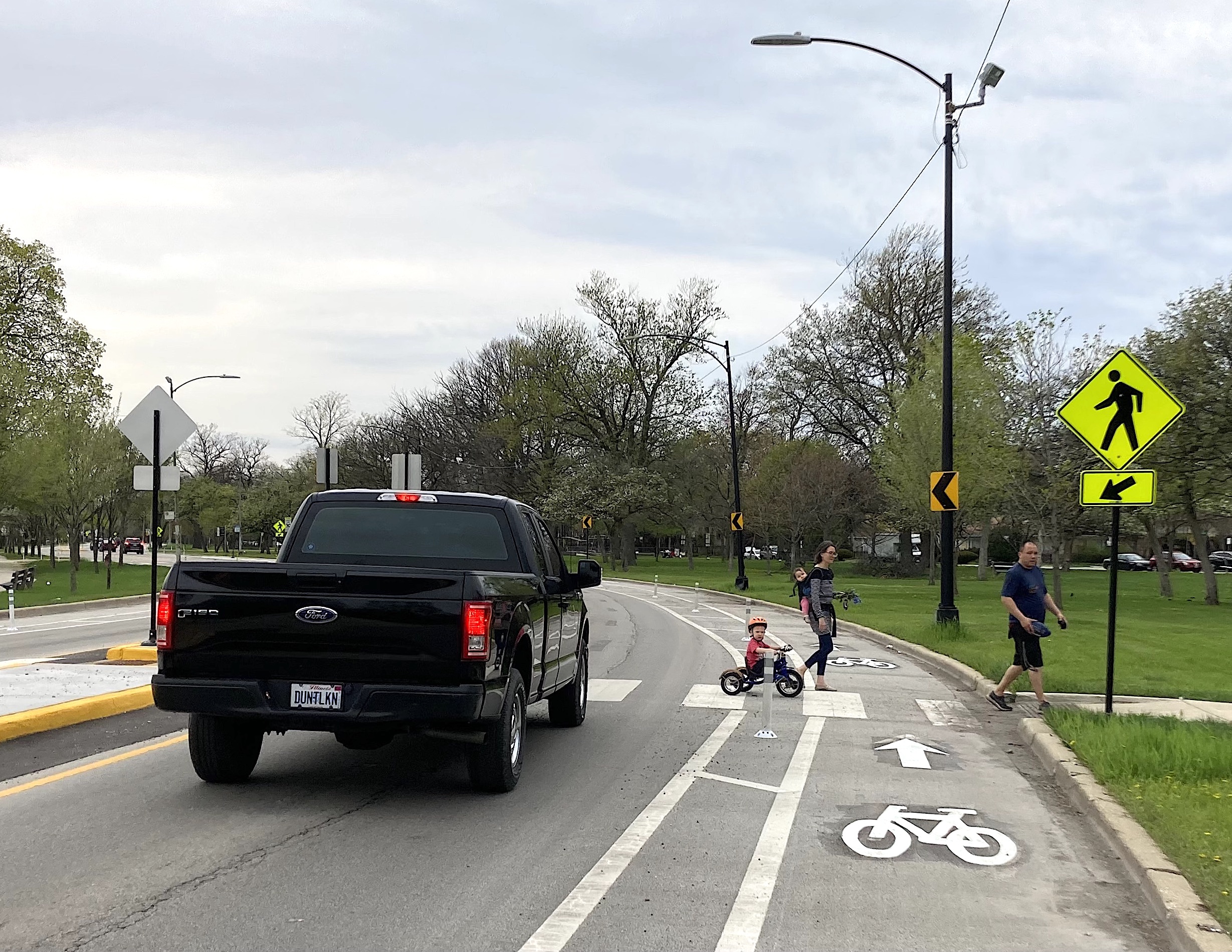Recently the Chicago Department of Transportation did a safe streets project on Jackson Boulevard in the Austin neighborhood's Columbus Park. It converted the half-mile-long, four-lane, high-speed road through the green space into a three-lane street with new pedestrian and bus-boarding islands, plus curbside bike lanes delineated with flexible plastic posts.
Last month Block Club Chicago reporter Pascal Sabino published an article about a backlash to the "road diet" from nearby neighbors. Some of them complained the new layout makes it less convenient to drive through the park – home to softball and football fields, a swimming pool, a golf course, and a playground – to access the Eisenhower Expressway.
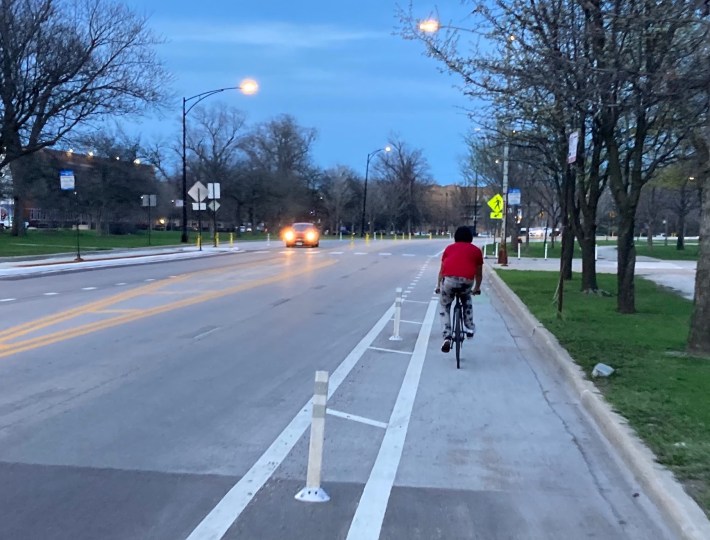
The residents said the Jackson redesign "caused chaos and confusion" and created "a traffic calamity" with "constant traffic jams," adding that they have "never seen a bicyclist along Jackson," Sabino wrote. Here are a few direct quotes from the neighbors included in the piece:
- "It’s absolutely horrible. It’s made it so congested I try not to even go down that way anymore."
- "No one uses it. What a waste of taxpayer money."
- "It’s a bike path to nowhere."
What was wrong with the Block Club article
I previously did a full deconstruction of the problems with the Block Club piece, including some inaccurate info and half-truths. Here's a recap of the main issues with Sabino's article.
- The headline states as fact, “A short bike lane on Jackson Boulevard… is causing traffic jams through Columbus Park” in the Austin neighborhood. But later in the piece Sabino admitted that may not actually be true: “Data collected from speed enforcement cameras doesn’t suggest major congestion or slowdowns, [CDOT] said.” The reporter also acknowledged the project is achieving its goal of discouraging speeding with a "10 percent speed reduction," according to department data.
- Columbus Park Advisory Council chair Bernard Clay is quoted as saying the city "didn’t hold any community meetings" on the project. The reporter later indicated to Streetsblog he was aware CDOT gave a presentation on the road diet/bike lane project at a November 17 ward meeting. However, he didn't mention that presentation in the article.
- Clay told Block Club that nearby stretches of Lake Street, Washington Boulevard or Madison Street would have been better locations for bike lanes because they're "wider" than Jackson's former four-lane layout. In reality, all of these streets are two-lane and/or already have bike lanes, but the reporter didn't fact-check Clay's statement.
- Clay is quoted as calling the new bikeway "a bike path to nowhere" because it didn't link to other bikeways at the time. At the November 17 meeting, CDOT announced that new bikeways will be installed later this year that will connect the Columbus Park lanes to the city's bike network. The reporter didn't mention that fact. After the Block Club piece was published, CDOT installed shared-lane markings ("sharrows") on the two-lane stretch of Jackson east of the park.
- It appears no Austin residents who walk to the park, catch buses there, or ride bikes are quoted.
The one good thing about Sabino's article is it highlighted the fact some neighbors felt they didn't get a fair chance to weigh in, even if that wasn't necessarily the case. (A CDOT spokesperson told me, "We tried to reach out to the park council, but didn't connect with them before the project started.")
Especially in Austin, a majority-Black community on Chicago's West Side, which has been harmed by racist government policies, it's important residents don't feel shut out of the transportation planning process. So in the future, CDOT should do a better job of publicizing the details of projects like this in advance, and spreading the word about opportunities for input.
Streetsblog Chicago pointed out the above problems with Sabino's piece in an April 14 tweet to Block Club's editors, suggesting that the piece be corrected or updated. It appears no changes were made.
What it's actually like in Columbus Park nowadays
Plenty of people on Twitter asked Sabino why he didn't interview any bike riders in the Austin neighborhood. The reporter responded to one of them by asserting, contrary to the CDOT data, the safety project is having "a demonstrably negative effect on the community."
Sabino added, "I could spend all day at Columbus Park waiting for a cyclist to ride by for me to talk to, and I'd come up empty-handed. There are literally zero cyclists who actually use those bike lanes."
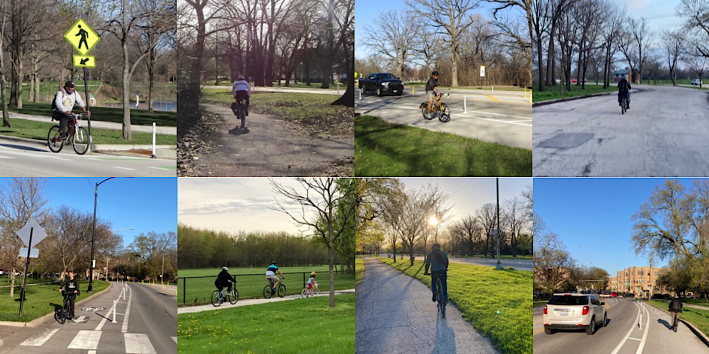
However, Streetsblog reporter Igor Studenkov and I stopped by Columbus Park four times in recent weeks, for a total of about three hours, and spotted 14 people on bikes, shown above and elsewhere in this post. That averages out to roughly one cyclist every 13 minutes. Six of them were using the bike lanes. Sabino's excuse for not interviewing any people biking in Austin makes no sense.
This healthcare worker who was commuting from a nearby hospital told me the formerly four-lane road "would be pretty sketchy without a bike lane."
I also talked with an Austin resident named Keisha who was waiting for the #126 Jackson bus in Columbus Park, who regularly rides that route. She said she sometimes uses the bus boarding islands in front of the park's refectory events building, and the pedestrian islands have made crossing Jackson easier. "I think it's pretty nice."
And I spoke with this motorist and former Austin resident named Debra who was cleaning her van next to the refectory. "I think it's good," she said. "People [came] through here flying. Now people take their time, slow down... watch for pedestrians. It's just a good thing."
These images and interviews give you a sense of what Sabino's article might have been like if he hadn't chosen to mostly provide the windshield perspective on the issue.
Emails reveal CDOT thought the Block Club article was ridiculous
I submitted a Freedom of Information Act request for emails sent and received by CDOT staff related to the Block Club story to get a better sense of what the department said about the project, and the article, behind the scenes.
Sabino first emailed then-CDOT spokesperson Mike Claffey on February 25th. "I've heard many, many complaints from residents about the bike lanes," the reporter wrote. "They say the lanes have created a nightmare for traffic since it's significantly narrowed the street."
On February 28, before responding to Block Club, Claffey emailed 29th Ward alderman Chris Taliaferro's assistant Byron Watson to ask what he'd heard from residents about the project.
"Only a few have called complaining about it," Watson replied. "Most are asking, why is this being done here?" He added that some people who live on the north side of the park previously mentioned how difficult it was to cross four lanes of traffic. "I would estimate out of ten calls maybe three have something negative to say."
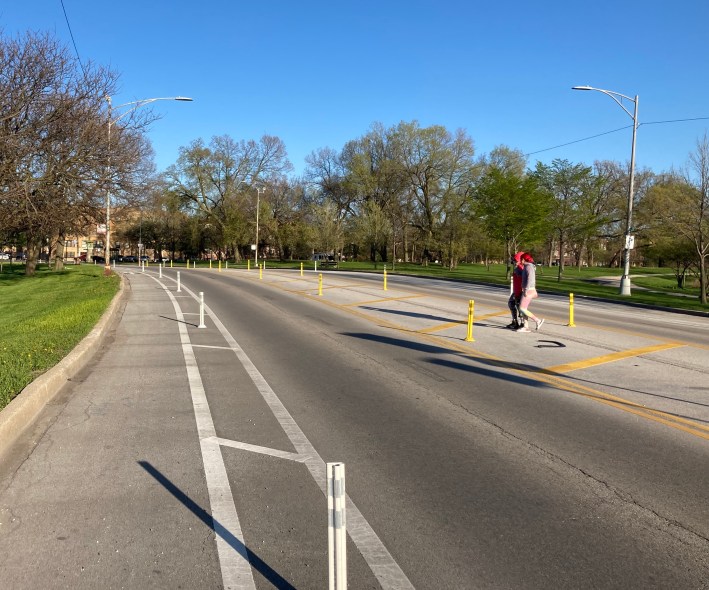
Claffey asked CDOT staff for data that would shed light on whether or not the road diet was causing serious traffic problems. Over the course of dozens of emails, they discussed traffic counts and speed camera data.
"The amount of traffic on this segment of Jackson... during rush hour is very low and would not create any traffic issues," wrote bike and pedestrian program manager David Smith on March 1. "We are not aware of any 'traffic nightmare' and the ward office has not indicated anything either."
On April 11, two hours after Sabino's article was published, CDOT deputy commissioner Vig Krishnamurthy emailed David Smith, as well as fellow deputy Jamie Simone and spokesperson Susan Hofer, in disgust. He noted that after CDOT had provided data showing the safety project isn't creating congestion, Block Club's headline still asserted it "is causing traffic jams," with only a brief mention of the stats halfway down the article.
"Feels almost in vain for us to give a comment with headlines like these, which position opinion as reality and bury the facts," Krishnamurthy wrote.
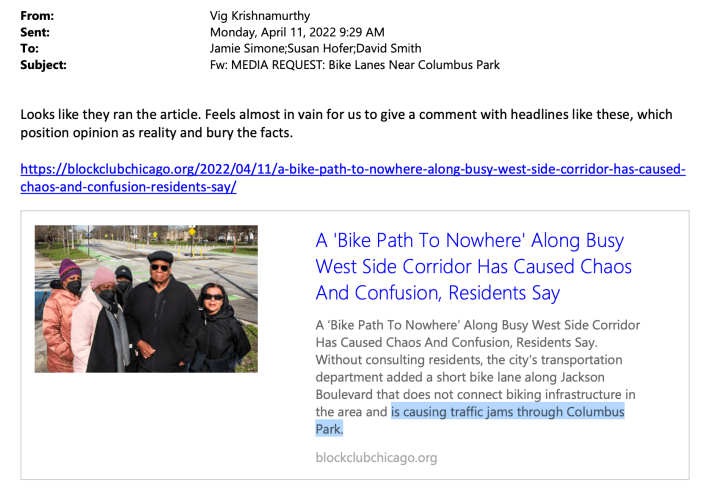
Replies from CDOT staffers to Smith's March 1 email, which noted the road diet wasn't actually causing a "traffic nightmare," nicely summed up the situation.
"One final point, which all us planners know," wrote John O’Neil, one of the CDOT transportation planners who analyzed the data. "The 'many, many complaints' that Mr. Sabino mentions may have been from just a few, very vocal individuals." He ended his message with a smiley face emoticon.
Spokesperson Mike Claffey replied, "Agreed – it doesn't take many gripers to come up with a story."
